Dry Needling by Solstice PT - FAQ
What is Dry Needling?
Dry needling is the use of acupuncture needles to improve healing of soft tissue (muscles, tendons, nerves and blood vessels) and decrease swelling, pain and muscular tightness. This technique is termed “dry” needling because the needles are very small, do not hold any liquid and cannot inject anything. When the small needle is inserted into the tissues, the body is stimulated to produce a healing response both at the area of the needle and throughout the body. Most people feel results immediately after treatment, and this can continue to improve with multiple sessions.
What can be treated using Dry Needling?
Commonly treated injuries: patellofemoral joint pain (runner’s knee), IT band syndrome, shin pain (shin splints), Achilles tendinitis, plantar fasciitis, neuropathies, patellar tendinitis, quadriceps tendinitis, hamstring tendinitis, whiplash injury, foot and ankle injuries, contusions, rotator cuff and biceps tendinitis, shoulder impingement, lateral epicondylitis (tennis elbow), medial epicondylitis (golfer’s elbow), arthritis, swimmer’s shoulder, thoracic outlet syndrome.
For injuries, dry needling can be used to treat contusions, muscle strain, ligament sprain, swelling, inflammation, deficient circulation and muscle soreness. It has been shown to provide faster and more specific recovery than any other known method.
Dry needling can be used as a tool for many other cases that may not be considered an injury. It is very effective with decreasing general muscle tension, eliminating trigger points, improving dysfunctional neurological issues, for patients with fibromyalgia and many other conditions.
How can Dry Needling help an athlete?
Dry needling therapy can be seen as a safe means of enhancing performance. Dry needling reduces mechanical and intrinsic stress in the musculoskeletal system. This increases the efficiency of energy consumption and will therefore increase the endurance of the musculoskeletal system, improving performance. In addition, regular dry needling as a “maintenance” factor improves recovery and regeneration from the damage caused by training and competition, enabling the athlete to recover faster and continue training at a higher level, thereby also potentially increasing performance. (Ma, Yun-tao. Biomedical Acupuncture for Sports and Trauma Rehabilitation, Dry Needling Techniques. Elsevier, 2010. Print)
Do I need to have an injury to benefit from Dry Needling?
No. Dry needling is used as a preventative treatment, to enhance muscular performance, to improve tissue integrity and pliability and to improve the general well-being of the body.
Is Dry Needling the same as acupuncture?
No. Dry needling uses acupuncture needles, but it is a tool that physical therapists use to perform deep soft tissue treatment. It is used to treat the muscles and nerves directly and is never used in distal (a location far away from the area that is being treated) or auricular points (in the ear), as in acupuncture. Dry needling is not based on qi, meridians or acupuncture points, but purely on neuromuscular principles as treated in physical therapy.
Does it hurt?
Practitioners can be trained in many different Dry Needling techniques. Dr. Lisa Wilcox has been trained through the Integrative Dry Needling Institute, which describes the technique as 80% pain-free. It is a gentle technique, but with great and usually immediate results. Many patients have tried other forms of dry needling and have been sore for a couple of days after the treatment. Dr. Wilcox’s technique leaves people feeling relaxed, looser and with minimal soreness.
What can I expect at each visit?
The initial consultation will focus on subjective history, tests and measures, and an initial dry needling treatment. Follow-up visits will include dry needling, soft tissue mobilization and can include stretching, exercise prescription and education regarding the condition. All treatment is conducted by a Doctor of Physical Therapy.
How soon can I expect to feel results?
Most people notice an improvement immediately. Every person is different with their responsiveness to Dry Needling but significant improvement should be felt within the first 1-4 visits. If an improvement is not seen, this indicates that the condition may need further evaluation through other medical professionals and a referral will be given.
Can I use my health insurance?
Upon request, documentation can be provided in order to submit a claim to your insurance company. Solstice PT also accepts HSA payments.
I already use a foam roller and get massage, is this different?
Dry needling improves tissue mobility and decreases soreness much faster than any other soft tissue work. It is more effective than foam rolling, and increases blood flow to the tissue which improves recovery time.
How often can I get dry needling?
1-2 times per week is the maximum that is offered per body part. If people have multiple different areas that cannot be treated in 20-30 minutes, more than 2 sessions can occur per week.
Where can I get treatment?
Dr. Lisa Wilcox, Solstice PT, completes convenient treatments in your home or office.
For further questions, or to schedule an appointment, please email Dr. Lisa Wilcox at info@SolsticeHealthcareResources.com, call (720) 369-7738 or contact through her website at www.SolsticePhysicalTherapy.com.

